Yellowstone in Winter 2: How to visit
No Comments
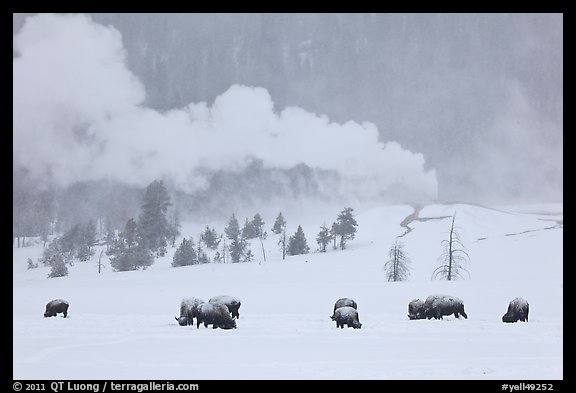
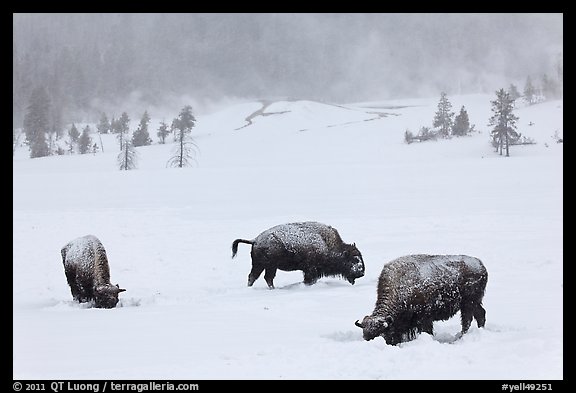
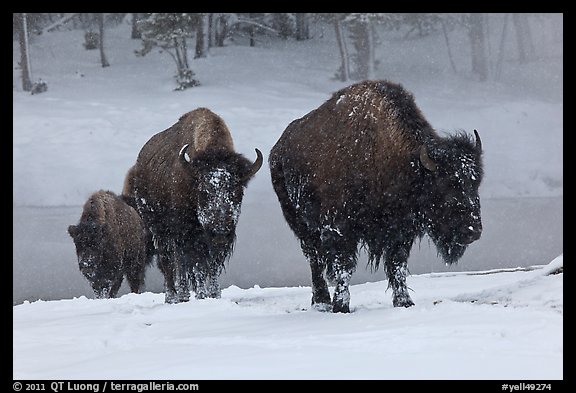
More Yellowstone Winter Wildlife pictures
All Yellowstone Winter pictures
The official winter season (during which lodges and roads are open) generally lasts from mid-December to the beginning of March. If I was to return to Yellowstone in winter, I would pick mid to end January. At the beginning of winter, the Park may not have enough snow (this was the case in 2010). While the relatively warmer February temperatures make the visit more pleasant than the bitter January cold, the latter may provide for better photo opportunities, since it would magnify the winter highlights that I described in the previous post.
To get inside the heart of Yellowstone in winter, you need transportation via a special track-equipped vehicle, since the interior roads inside the park are not plowed. This means either a snowcoach or a snowmobile. Because I knew that the National Park Service had been trying to get rid of snowmobiles for a while (*), I chose transportation by snowcoach. Besides, currently all snowmobiling in the park needs to be guided, so unless you hire a private guide, you’ll be joining a tour which may not offer more flexibility than a snowcoach ride – and much less comfort. Be sure to make arrangements well in advance, as the number of snow vehicles allowed to enter the park is strictly limited.
You will also need accommodation inside the park. Two lodges open in winter, the Old Faithful Snow Lodge, and the Mammoth Hotel. If you are coming from the south, you arrive late and depart early at Old Faithful, so an absolute minimum of two nights is necessary if you want to have any time to explore the Upper Geyser Basin. The reservation website offers only options to book lodging and transportation separately, but there are a number of packages combining both which provide you with better deals. Those packages were not listed on the website, so be sure to inquire about them. Our “Frosty Fun” package included discounted prices, free breakfast, and a voucher that will pay for ski rentals or a gift. Since the rooms in the Old Faithful Snow Lodge are all doubles, the trip is most cost-effective for a party of at least two. I traveled with Mike Cavaroc, an excellent and friendly nature photographer, videographer, and web designer based in Jackson.
The Mammoth Hotel is more peripheral, and can be reached by car. However it is a 300 miles, 7 hours drive from Jackson to there. Coming from the South, to check both locations while enjoying a snowcoach ride in the northern part of the park rather than a long drive, you could add two nights at the Mammoth Hotel in the middle of the itinerary. Again, be sure to make arrangements well in advance of your stay.
The ride from the South Entrance (Flagg Ranch) departed at 12.30 and arrived at sunset. On the way, the snowcoach made short stops at the entrance sign, Moose Falls, and Lewis Falls, and a longer one (of about 45 minutes) at the West Thumb Geyser Basin. It was packed to maximum capacity (10 passengers). As there was hardly any space, I had to leave my photo backpack outside (where it was not easily accessible), clutching a smaller shoulder bag on my knees. Because I didn’t pay enough attention during loading, my tripod also ended up outside, with the rest of the baggage, which prevented me from smoothing the water with long exposures for the waterfall shots. The ride out from Old Faithful left just after breakfast, and arrived at about noon at Flagg Ranch, with just two short stops at Kepler Cascades and West Thumb. The rides, esp. the ingoing one, double as a tour (interesting narration) but contrarily to what is reported in the Photograph America newsletter, the snow coach drivers will not stop whenever you ask. They have a schedule to keep, and will remind you of this if you linger too long during the scheduled stops.
We stayed for three nights. For our first day at Old Faithful, we explored on foot the Upper Geyser Basin, up to the Morning Glory Pool. Skis are not necessary through this area, as the snow is packed on trails. On our second day, we rented cross-country skis, with the intention to travel further, although we made it only to Biscuit Basin, owing to a late start. I had originally planned to stay longer and take snowcoach tours out of Old Faithful but those tours had filled up early. I would advise making reservation for those long in advance, as they actually fill up way before the hotel itself does.
The temperature varied from single digits (F) to twenties, and did not feel that cold. In fact, I felt that the Jackson Hole valley, with its constant winds was colder than Yellowstone. To my surprise, relatively thin gloves turned out to be sufficient. Sorel Glacier snow boots were great, plenty warm and comfortable. On the first day, I wore a big down-filled parka, which was useful as we were often staying in the same spot for extended periods of time. As the second day on skis promised to be more energetic, I traded it for a small, sleeveless down vest, worn below a Goretex shell.
Prior to the trip, I was wary of about cold weather photography issues, since with the exception of the Mt McKinley summit (where the cold did cause unexpected problems) I hadn’t photographed in extremely cold weather. I did the best to prepare myself. During most of the time I was in Yellowstone, it snowed, sometimes quite heavily. However the snow was so dry that it did not stick to cameras and lenses. My lightly sealed Canon 5D mk2s had no problem. I just made sure to brush the snow off from the lens by wiping it with a piece of cloth rather than blowing on the lens, which would have caused condensation. Speaking of which, I anticipated serious condensation problems upon getting inside because of the large temperature differences (condensation occurs when moving from cold to warm) but it turned out to be not that bad. In the case of getting back onboard the snowcoach, just making sure the lens cap was on prevented problems. Upon getting back into the lodge, keeping the camera bag zipped for a while to give time to gear to warm up progressively was enough. I didn’t have to use the large plastic bags that I had brought to wrap the camera bag. The spare batteries kept in an inside pocket performed well. With a few simple precautions, I think the mid-February temperatures were not cold enough to cause any problems. I am looking forward to return at some point for a mid-January trip.
* As background information, the National Park Service, after numerous scientific studies, had concluded that snowmobiling causes significant toxic levels of air pollution, haze, pervasive engine noise, and wildlife harassment. The Clinton administration decided to phase out use of snowmobiles and provide winter access only on snowcoaches, cleaner, quieter, and carrying many passengers. However, the snowmobile industry challenged the phase-out decision in courts, and subsequently the Bush administration reverted the ban.
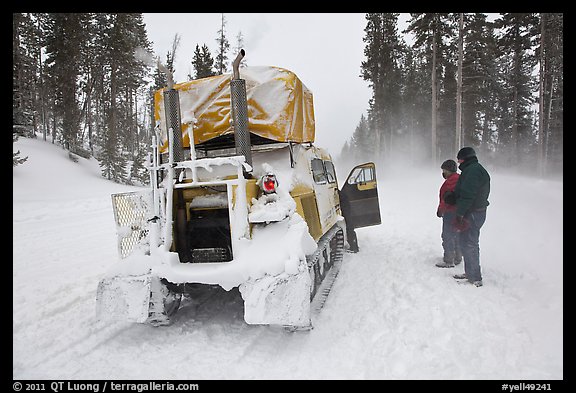
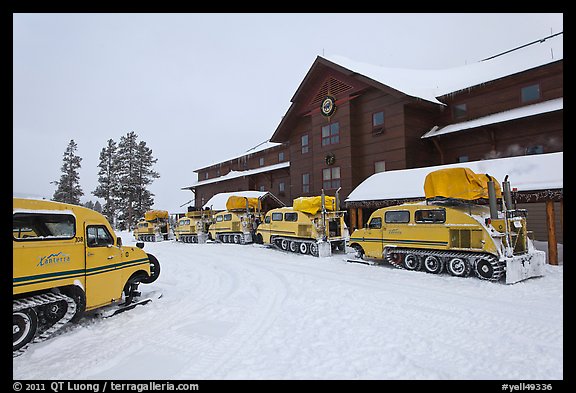
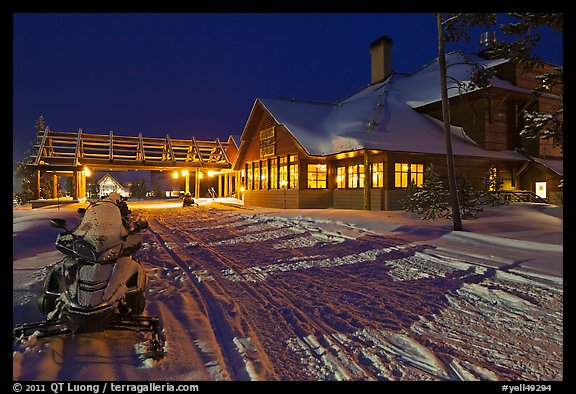
All Yellowstone Winter pictures

